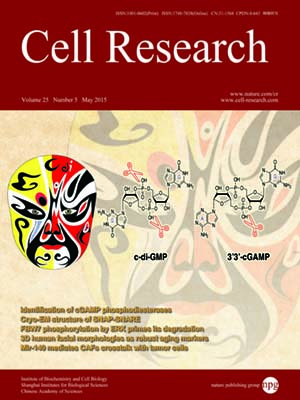
Volume 25, No 5, May 2015
ISSN: 1001-0602
EISSN: 1748-7838 2018
impact factor 17.848*
(Clarivate Analytics, 2019)
Volume 25 Issue 5, May 2015: 604-620
ORIGINAL ARTICLES
Structural basis for the neutralization of hepatitis E virus by a cross-genotype antibody
Ying Gu1,2,*, Xuhua Tang3,4,*, Xiao Zhang2, Cuiling Song1, Minghua Zheng1, Kaihang Wang1, Jun Zhang2, Mun-Hon Ng1,2, Choy-Leong Hew3,5, Shaowei Li1,2, Ningshao Xia1,2 and J. Sivaraman3
1State Key Laboratory of Molecular Vaccinology and Molecular Diagnostics, School of Life Sciences, Xiamen University, Xiamen, Fujian 361005, China
2National Institute of Diagnostics and Vaccine Development in Infectious Disease, School of Public Health, Xiamen University, Xiamen, Fujian 361005, China
3Department of Biological Sciences, National University of Singapore, Singapore 117543, Singapore
4Current address: Institute of Molecular and Cell Biology, Singapore 138673, Singapore
5Current address: Mechanobiology Institute, National University of Singapore, Singapore 117411, Singapore
Correspondence: J. Sivaraman,Shaowei Li,Ningshao Xia(dbsjayar@nus.edu.sg , shaowei@xmu.edu.cn , nsxia@xmu.edu.cn)
Hepatitis E virus (HEV), a non-enveloped, positive-sense, single-stranded RNA virus, is a major cause of enteric hepatitis. Classified into the family Hepeviridae, HEV comprises four genotypes (genotypes 1-4), which belong to a single serotype. We describe a monoclonal antibody (mAb), 8G12, which equally recognizes all four genotypes of HEV, with ~2.53–3.45 nM binding affinity. The mAb 8G12 has a protective, neutralizing capacity, which can significantly block virus infection in host cells. Animal studies with genotypes 1, 3 and 4 confirmed the cross-genotype neutralizing capacity of 8G12 and its effective prevention of hepatitis E disease. The complex crystal structures of 8G12 with the HEV E2s domain (the most protruded region of the virus capsid) of the abundant genotypes 1 and 4 were determined at 4.0 and 2.3 Å resolution, respectively. These structures revealed that 8G12 recognizes both genotypes through the epitopes in the E2s dimerization region. Structure-based mutagenesis and cell-model assays with virus-like particles identified several conserved residues (Glu549, Lys554 and Gly591) that are essential for 8G12 neutralization. Moreover, the epitope of 8G12 is identified as a key epitope involved in virus-host interactions. These findings will help develop a common strategy for the prevention of the most abundant form of HEV infection.
10.1038/cr.2015.34
FULL TEXT | PDF
Browse 2009


